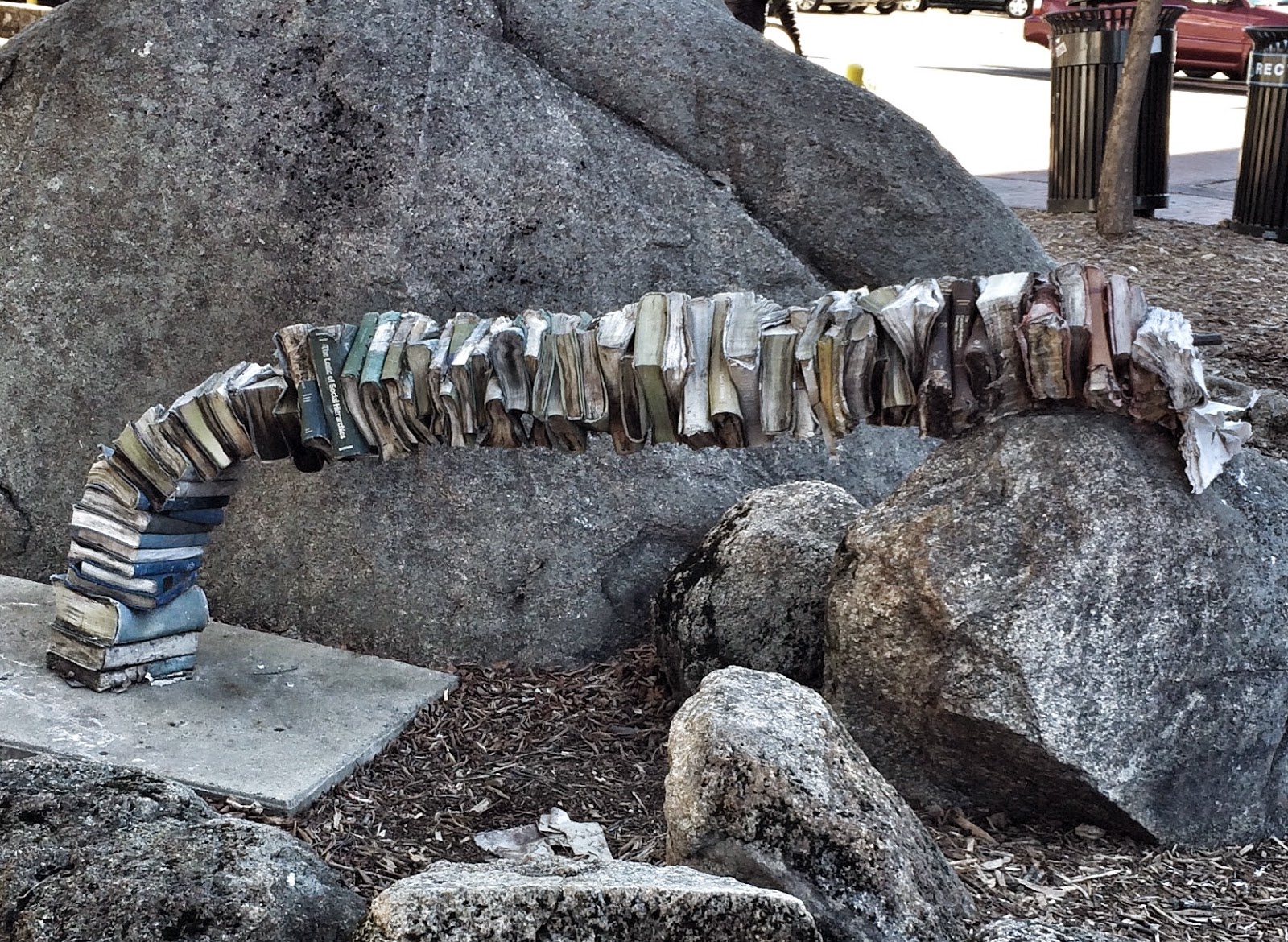Untitled Sculpture
Lee Delegard, 2012
"Untitled"
Lee Delegard’s sculpture “Untitled” on the campus of UNC-Chapel Hill invites viewers to consider the fragility of manmade objects and human knowledge and their link to greater ecological forces. Little is known or published about the sculpture, which is hidden by a pile of rocks on the north side of campus. William Thomas, director of student services in the UNC-CH art department, confirmed Delegard was the sculptor, it was without a title, and she created the piece in 2012 while working toward a Master in Fine Arts. There is no artist statement—no plaque and no website.
This mystery surrounds the piece in questions. Unlike most public sculptures, for example the “Bean” in Chicago, “Untitled” is hidden from view. The arching shish kabob of books is concealed by decorative boulders and a cypress tree, but after noticing the piece, the curiously hidden sculpture prompts viewers to keep asking: why?
The artist and sculpture are silent, but there is an answer in the objects, books specifically, that provide commentary on humans and their relationship to the environment. Books are symbolic of knowledge and human progress, and in the context of human history, their distribution corresponds with human progress. Gutenberg’s printing press propelled the world into the “Age of Enlightenment,” allowing people to share their thoughts with enormous audiences. Books are valued and treasured, and even today, are expensive resources. Watching the hardback books of Delegard’s work, unprotected and rotting from the forces of nature, is disturbing and seems disrespectful to our pursuit of knowledge. But the books’ decomposition illustrates a truth that cannot be ignored – humanity will eventually decompose. This fact, the subject of even ancient books like the Bible’s Revelations, is distressing in light of humanity’s constant desire for self-preservation. An end is coming that even vast libraries of information cannot prevent.
In the wake of such apocalypse, the artist wants the viewer to reconsider his or her relationship to material things, human ideas, and human institutions. An exhibition statement for the 2012 exhibit “Tooth for an Eye” described Delegard’s sculptures as, “exploring precarious relationships between juxtaposed materials, viewing them as analogous to the unsustainable connections between identity, consumer goods, and the limitations of art as a language itself.” She wants her audience to consider their “unsustainable connections,” especially their social constructs. The books chosen for “Untitled” are about oppressive human institutions, with titles like "The Logic of Social Hierarchies" and "Labor Reactions.” Delegard’s message is dismal, yet beautifully liberating. Only when we detach ourselves from the books and we accept the natural processes–the wind and rain destroying the paper–can we appreciate the beauty of Delegard's work. Watching the sculpture’s fallen pages melt into the earth, the viewer experiences a feeling of liberation. It incites an appreciation for the natural world that transcends the human experience, littered with the suffering and oppression probably discussed in the pages of "The Logic of Social Hierarchies."
Decay is an important aspect of Delegard’s sculpture, which is interesting considering that forces from the natural world are rarely appreciated as art. Often artists create and expect their creations to outlast their lifetimes, and conservators constantly fight time and decay, as they desperately try to keep the work as fresh as when brush touched canvass or chisel chipped marble. Rarely are these natural forces appreciated as a feature of the art. People often praise the most complete, most unobstructed sculptures like Michael Angelo’s “David.” Less often do they praise the works of Renaissance masters whose work time and weather have eroded, making them seem somehow inferior or incomplete. But these corrosive forces are essential to Delegard’s “Untitled,” and lend an environmental aspect to her work.
“Untitled” challenges viewers to consider their relationship to the manmade and natural world, which reveals a need to preserve and protect the environment. Considering this relationship between the manmade and natural world, one realizes that earth and humans are both impermanent entities and humanity, with its various capacities, should be concerned with preserving the environment. Sustaining the ecological processes that are also destroying the sculpture is essential to preserving it. Without the water and wind of earth’s atmosphere and the weather destroying Delegard’s sculpture, humanity would cease to exist.


Comments
Post a Comment